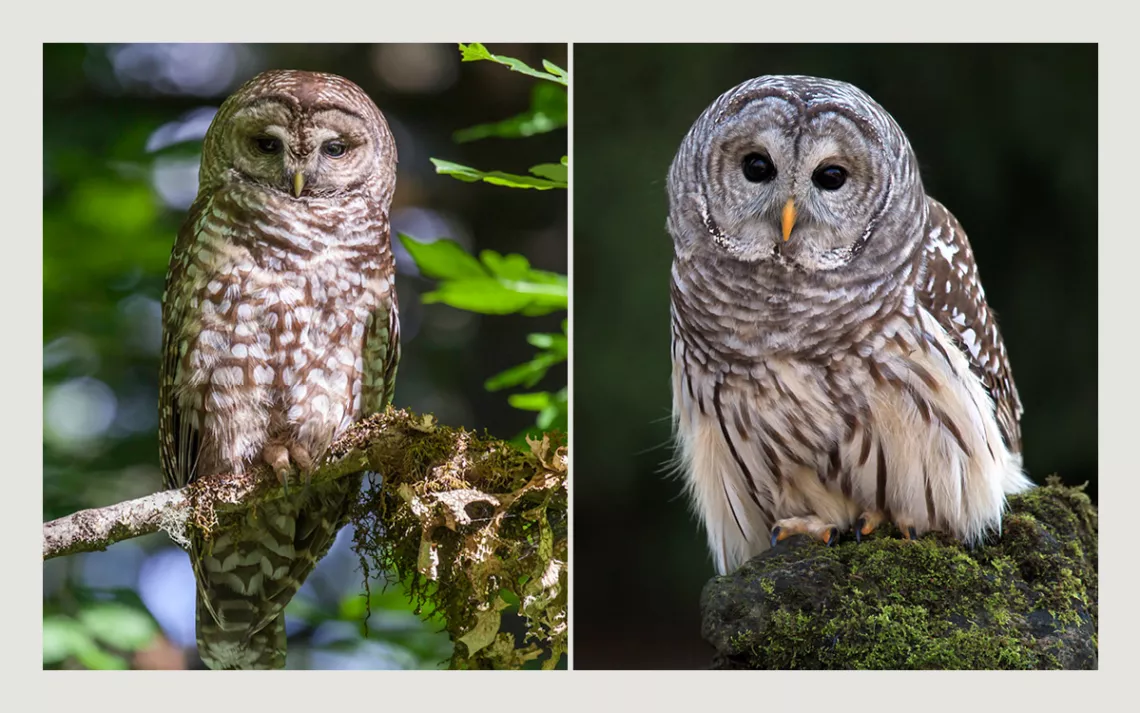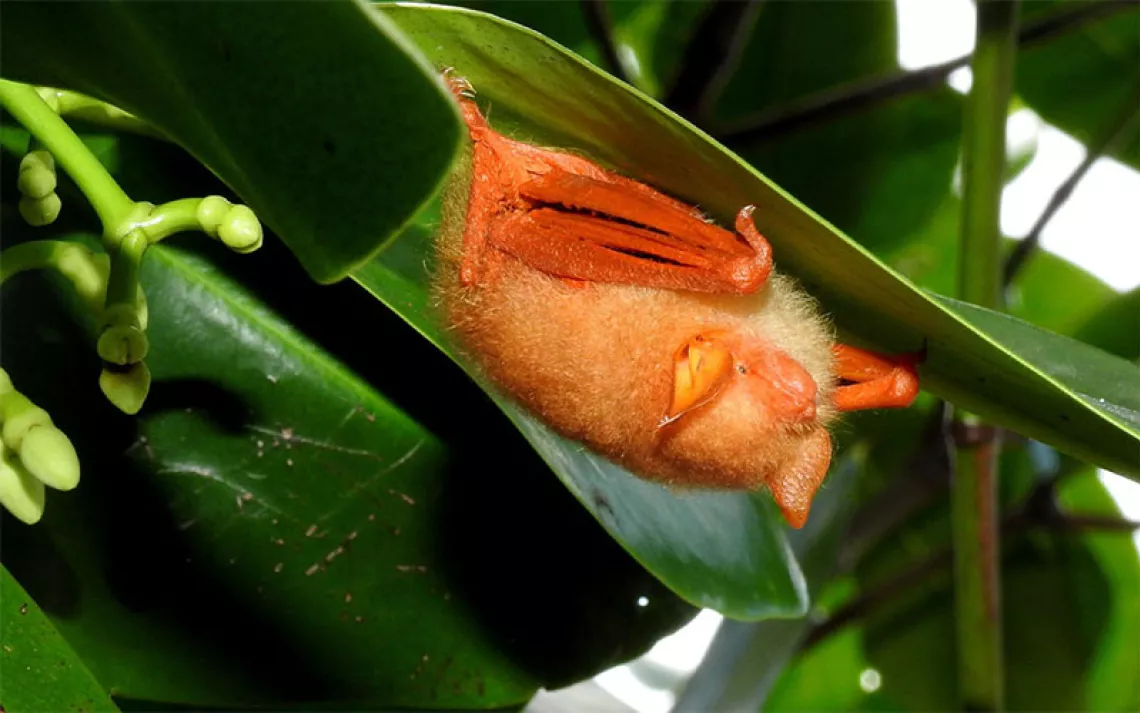Owl Vs. Owl
A Fish and Wildlife Service proposal to save northern spotted owls by killing barred owls splits conservationists and wildlife lovers

Left: Barred owl | Photo by iculizard/iStock. Right: Spotted owl | Photo by step2626/iStock
The barred owl is one of the largest and most familiar owls in the Pacific Northwest. The chance to hear its distinct call (Who cooks for you?), see its mottled white and brown feathers flash through the trees, or glimpse its round eyes can “lure dozens of people into a cold, dark forest for a bird outing,” writes Birds Connect Seattle. It’s a bird that, in the last generation, has become the region’s neighborhood owl.
But the barred owl is a relatively recent arrival to the Pacific Northwest—and today, it poses a threat to the native northern spotted owl, a species that has faced significant population decline in the last few decades. The bird has been listed as a threatened species under the Endangered Species Act since 1990, and between 1995 and 2017 alone, the northern spotted owl population declined by at least 65 percent. Among the various threats to the spotted owl—like habitat loss through logging and wildfires—the US Fish and Wildlife Service considers the barred owl the most pressing.
In an effort to save the northern spotted owl, the service is proposing killing up to 470,000 barred owls over the next 30 years across the Pacific Northwest as part of its latest barred owl management strategy. The proposal is sparking intense controversy; during a public comment period from November to January, the FWS received over 8,600 comments. It’s forcing bird enthusiasts and conservation advocates to confront a wrenching question: How far are we willing to go to protect a threatened species?
Killing one species to save an endangered species is not a new idea. On the Columbia River, federal officials have permitted state and tribal authorities to kill hundreds of sea lions to protect threatened salmon and steelhead populations. Killing barred owls for the sake of spotted owls isn’t a new idea either—the FWS first experimented with doing so in 2009. But the new plan is striking in its scale and scope: killing up to half a million owls across thousands of square miles in three states.
The idea has driven a wedge among conservationists normally joined together by the shared value of wildlife protection. Some organizations have criticized the plan as unethical and likely ineffective. In a March letter to Interior Secretary Deb Haaland, 75 wildlife and animal rights groups slammed the proposal, writing, “The plan to kill barred owls is a colossally reckless action, almost unprecedented in the history of American wildlife management. It should be sidelined with all deliberate speed.”
But others have expressed support for the FWS’s proposal, including Birds Connect Seattle. “Though we endorse the lethal management of one species to preserve another—and that being a common conservation practice—that does not negate the fact that it is a conservation tragedy,” Claire Catania, executive director of the Seattle affiliate of the national Audubon Society, told Sierra. “Our endorsement of this strategy is not a celebration of its necessity; we are all deeply affected by this, and should be . . . it really is lose-lose.”
THE HISTORY OF THE SPOTTED OWL is intimately tied to the animals’ habitat in the old-growth forests that used to cover the Pacific Northwest. Logging defined the region’s economy in the 19th century, and by the mid-20th century, private lumber companies started to harvest timber on federal lands. In 1963, timber cut on federal lands surpassed that taken from private lands for the first time: “Managers of federal forests were shifting from a mostly custodial role to an active participation in the region’s timber economy,” according to the Oregon History Project.
By the 1970s, forest managers had become aware that logging was impacting the well-being of the northern spotted owl. Between 1979 and 1983, the Department of the Interior adopted timber management plans designed, in part, to address the loss of owl habitat. In 1987, the Bureau of Land Management completed a “Spotted Owl Environmental Assessment.” Yet logging of old-growth forests continued, which prompted environmental groups, including the Portland Audubon Society and Sierra Club Legal Defense Fund, to sue the federal government.
The northern spotted owl quickly became a symbol of the larger battle over forest stewardship. To environmentalists, the owl was at once a beloved mascot that could help enlist public support and a legal vehicle for saving the fast-disappearing old-growth forests. To loggers, the owl was a detested critter that threatened to destroy rural economies. Someone created a popular T-shirt that read “Save a Logger, Eat an Owl,” and the “Timber Wars” became national news.
The contest over old-growth logging reached a turning point in 1990 when the northern spotted owl was listed by the FWS under the Endangered Species Act. Under the White House–brokered Northwest Forest Plan, finalized in 1994, timber companies would have to leave at least 40 percent of old-growth trees intact within a 1.3-mile radius of spotted owl nests.
But even with reduced logging in old-growth forests, the spotted owl population fell. Land managers soon identified a culprit: the spotted owl’s cousin, the barred owl. Over a century, barred owls had dramatically expanded their range, migrating from the forests of the East Coast, up into northern Alberta and British Columbia, then down into the Pacific Northwest, where they arrived by 1965. Barred owls are larger and more territorial than northern spotted owls, and so they quickly became a threat to both the spotted owls and the larger ecology of the forests they took over.
“By 2004, when we did a review of the spotted owl listing, [barred owls] had risen to the point of being a primary threat,” said Robin Bown, the FWS’s barred owl management strategy lead. In 2009, the FWS began mulling a northern spotted owl recovery plan: It eventually called for a new experiment to save the spotted owl by killing 2,000 to 4,000 barred owls over three to 10 years.
The idea sparked controversy then too. Kent Livezey, then a biologist with the FWS, wrote that this level of killing would result in the death of “143 times more owls during its first year than are being killed annually in all other conservation efforts combined in the United States and its territories.”
The FWS hired Bill Lynn, a wildlife ethicist, to assist in addressing the ethical dilemma of killing one owl to protect another. “They knew this would generate a firestorm of controversy, killing owls like this,” Lynn said. The first-ever “Barred Owl Stakeholder Group” was formed in 2009, led by Lynn. The group concluded that humans have a responsibility to protect the well-being of both owl species, as well as the biodiversity of the forests—but doing so would have to strike a delicate balance. “The threats facing northern spotted owls are of crisis proportions,” Lynn wrote in an ethics brief in 2011, “and hard choices may be necessary.”
Ultimately, the group decided that the FWS’s plan to kill barred owls was necessary, albeit controversial. The group had two caveats: First, that the FWS research nonlethal barred owl removal methods, and second, that the protocol for killing barred owls be strict, with specific guidance on how trained sharpshooters could provide quick and painless deaths.
Lynn knew then that giving the FWS an ethical green light could lead to an expansion of the program. “If this removal is successful, it may eventually lead to a policy of removing many thousands of barred owls each year in the Pacific Northwest,” Lynn wrote. “That level of killing, especially as it accumulates over time, should be of significant concern to all.”
Today, Lynn says the latest strategy is “wrong on multiple accounts,” pointing to the fact that the FWS didn’t call for renewed ethical considerations—despite the plan being scaled up so significantly.
He’s not alone in his opposition. In their spring letter to Secretary Haaland, the 75 animal rights organizations opposed to the plan argued that the strategy is unworkable at the proposed scale. They also argued that barred owls should no longer be considered an invasive species just because they once lived on the other side of the country. The strategy “victimizes a native species engaging in range expansion because of climate disturbance,” the letter read.
For his part, Lynn also argues that the benefit to the spotted owls doesn’t seem great enough to justify the killing of the barred owls. “We have a virtually unlimited amount of harm being delivered to barred owls, for very little result,” Lynn said, pointing out that barred owls would only be killed in up to a third of the northern spotted owl’s range. “This is the question of tragedy, moral injury, moral grief. It really is. There are times when you can’t save the patient, or when doing so will do such grievous harm that on balance, you don’t. . . . That applies to barred and spotted owls as well. Where is the endpoint? Is it an unlimited killing?”
THE FISH AND WILDLIFE SERVICE points to the outcome of the initial experiment as a reason to scale the strategy up. Robin Bown, the barred owl management lead, said that in areas where barred owls were killed, spotted owls experienced a population stabilization, compared with a 12 percent decline in populations where barred owls were not. She also pointed out that the loss of even 470,000 barred owls won’t make a significant dent in that species’ total numbers. “We’re not going to eliminate them from the West, and we’re not trying to,” Bown said. “But if we manage them, and if we can find pockets of areas where we can keep our native spotted owls—at least for now—then we will have both our species.”
“Ethically, it’s not comfortable for people,” Bown continued. “But if we don’t do it, we lose our species. If we do it, we can have both.”
The fact remains that under the Endangered Species Act, FWS has a legal obligation to do something. “There’s not a clause in the act that says, ‘things are so bad, we’re going to give up,’” said Katherine Fitzgerald, the northern spotted owl recovery lead with the FWS. “What it says is that we should conserve threatened and endangered species, which means work toward recovery. That’s what we’re obligated to do, and that’s what we’ll do.”
Officials don’t share skeptics’ worries about the plan’s feasibility. While it’s unclear exactly how many sharpshooters the service will work with, the agency plans to structure a program that, in Bown’s words, can “work with pretty much any interested land manager or landowner.” There are 11 agencies—including the Bureau of Land Management and the National Park Service—involved in the effort already. Each sharpshooter will need to provide documentation of training in barred and spotted owl identification, firearm skills, and experience with barred owl removal.
Bown said the FWS will have a final environmental impact statement review by the summer, and a final barred owl management strategy shortly after. At that point, it will apply for a permit under the Migratory Bird Treaty Act to legally kill barred owls. According to the FWS, the plan can save both the northern spotted owl and the larger forest. “Barred owls are having effects that we don’t understand yet to the ecosystem,” Fitzgerald said. “I don’t think we want to necessarily find out when something goes very wrong.”
To Claire Catania of Birds Connect Seattle, the clarifying fact is that northern spotted owls are in crisis, and something must be done.
“You cannot equate individual lives of individual owls with the value of a unique branch on the tree of life,” Catania said. “We don’t want this to be the end.”
 The Magazine of The Sierra Club
The Magazine of The Sierra Club



